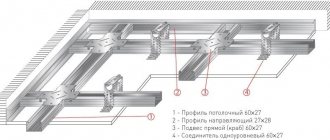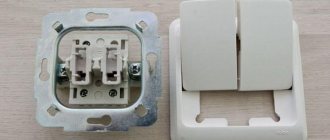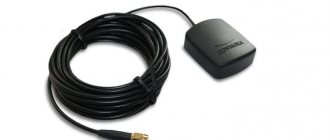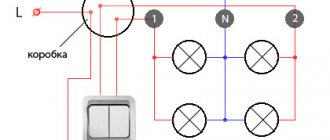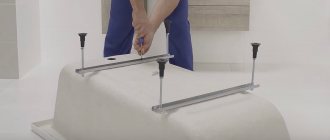How to secure a wooden ladder
There are two ways to purchase a wooden staircase - buy a ready-made one or order it according to an individual project; you can also make the product yourself.
Many people, having spent a fairly large amount on a staircase, save on its assembly and try to mount the structure with their own hands. Serious staircase manufacturers, who care about their reputation and the convenience of the client, adjust all the details at the rough assembly stage. Later, the staircase is disassembled, covered with various protective impregnations, painted, if provided, and reassembled. Therefore, self-assembly of such structures does not cause any particular difficulties, of course, if you have the minimum skills and the necessary tools.
Since staircase structures come in different types, installation methods also differ. But there are rules that apply to all options:
- Number the parts if the manufacturer did not do so;
- Location of doorways in relation to the interfloor area;
- According to the numbering, determine the assembly sequence;
- If the walls and floor are not too smooth, then level the surfaces;
- Put first those elements that will be difficult to get to later;
- If the accuracy of the design is in doubt, then it is better to start installation from the top, then it is easier to adjust the length of the march.
All staircase structures are divided into two large categories:
- Marching;
- Radius;
They, in turn, are divided according to the type of fastening of the steps:
- Console.
How to attach steps to a wooden staircase of this design:
- Using a profile, which is then covered with plasterboard or other material.
- They cut into the wall 20-40 cm;
- With the help of a cable, it also replaces the handrails;
- On the bolts, which are attached to the wall with pins, steps are pulled together on the other edge;
- Attached to welded metal stringers.
- On the bowstrings
These are boards or beams that cover the ends of the steps. From an aesthetic point of view, such stairs look attractive. And in this case, it’s immediately clear how to install balusters on a wooden staircase .
- On the stringers
A very reliable, but labor-intensive fastening, also involves several types (embedded steps, on fillies). Stringers are load-bearing beams on which the steps rest.
How to draw a diagram of a house staircase with your own hands
If you want, you can draw the diagram yourself; you need to know about certain features that you should pay attention to. You should have at hand:
- Construction tape.
- Chalk or felt-tip pen, which will be used to make marks on the surface of the walls and floor.
- Pencil or pen.
- Paper sheet.
- Compass.
- Ruler.
Such accessories are quite enough to make the required drawings for a wooden staircase in a private house.
Step-by-step algorithm for drawing drawings
When you get your hands on it and a person begins to draw drawings of wooden stairs to the second floor on a paper sheet, you need to act step by step:
When performing step-by-step actions, stick to the order; making a drawing of wooden stairs will not be difficult.
What is important to pay attention to
When taking measurements, be sure to pay attention to the following nuances:
Taking into account such details, there is a chance of drawing up the most accurate drawing of the staircase that leads to the upper floor.
Wooden street structures
Exactly because of this reason:
For this reason, if you made the drawings with your own hands, then be sure to take this factor into account. This action will minimize the risk of rotting of the material.
Advantages
Those who decide to place a wooden staircase on the street can highlight many advantages for themselves:
In this case, small errors are allowed, because the fact that the staircase structure turns out to be a little longer or wider plays a role in the house, and not outside. For this reason, measurements should be taken, but not all indicators are needed. For example, for the street there is no need to measure the space from the ceiling to the step, which must be done in the house. This is not the entire list of advantages; each dacha owner can highlight his own. And yet, along with positive qualities, there are also negative sides.
Flaws
The disadvantages are:
- Exposure to natural factors.
- A wooden staircase outdoors needs good care.
Knowing the advantages and disadvantages, all home owners will be able to determine for themselves whether to rely on staircase installation in an open space or not.
With “confident” carpentry skills and a thoughtful approach to the work, you can do it yourself, but you need to remember: stairs are critical structures that must be 100% safe. Complete reliability can only be ensured by accurate sizing calculations, competent manufacturing and installation, taking into account specific nuances.
Fastening the marching structure
Installation is carried out in the following sequence:
How to fasten a wooden staircase to the second floor with bowstrings
There are two types of staircases on bowstrings - when the load-bearing element is on one side, and on the other the steps are attached directly to the wall. And the second option - the bowstrings are on both sides and cover the ends of the steps. Each type has options:
- Straight;
- Rotary;
- In several flights;
- With intermediate platform;
- With winder steps.
A staircase structure with two bowstrings is first assembled on the floor. If you purchased a ready-made structure that just needs to be assembled, the strings already have special slots for the steps. If the staircase is made at home, then all stages are done independently.
Slots are made in the load-bearing beams (50 mm board) corresponding in size to the thickness, width and configuration of the steps. After the cuts are made, you can prepare the bowstring in advance for attaching to the wall. To do this, through holes are made in it for special anchors at a distance of 30-50 cm from each other along the entire length. Then, placing the string against the wall at the installation site, points for fastenings are marked on it through the holes.
To avoid misalignment or mismatch, a template is made from plywood, with which markings are made on both strings. The marking is done in mirror image. The depth of the slots cannot be less than half the thickness of the board (25 mm). It happens that the slots are made right through and then the ends protrude beyond the string.
If the staircase begins with winder steps, then the slots in each string are made according to their size. On the one hand - for the wide part, on the other - for the narrow part.
As a rule, such stairs are made open, that is, without risers. If there are risers, then slots are made in the bowstrings for them too. Before assembling the structure, all elements are impregnated with fire retardants and antiseptics.
Stair elements
Wrought iron balusters for stairs photos, styles, products.
Installation of railings and balusters of a wooden staircase Railings of a wooden staircase
Thin balusters
Massive balusters
The main and mandatory components are supports, steps and railings. The shape of the elements is noticeably different.
- Stringer is a sawtooth-shaped supporting inclined beam to which treads are attached. It can be one or several, the steps on it are installed from above.
- The bowstring is an inclined straight beam, but the tread is fixed between two supports.
- A step is a flat element of a staircase on which one rests while moving.
- Railing - stair railing.
The methods of fastening elements to each other may be different, therefore, for example, load-bearing beams, despite their role as support, may be absent altogether.
- Wall – treads can be installed in a load-bearing wall. On the opposite side of the stairs, the steps are fastened together with bolts.
- Modules are a connecting element that fastens the treads together and acts as a support beam. For this design, the support on the wall is partial.
- Frame - a metal structure consisting of a supporting beam of minimum width - 12–18 cm, and stepped bases
Attaching steps to stringers and bowstrings
Load-bearing beams are an indispensable component of wooden stairs, therefore connection methods are described for wooden elements.
Fixing the tread on the beam depends on the method of its manufacture.
- Zigzag protrusions are cut out in a board of the appropriate size according to calculations. Holes are made in the treads, then the stepped elements are installed on stringers and secured with screws. The screws are covered with wooden plugs on top. The photo shows the traditional method of installation on a stringer.
- You can do it differently: attach rectangular supports to the support beam on spikes, and then mount treads on the supports.
Other methods are used to secure elements to the string.
- On the inside of the board, grooves 2–3 cm deep are cut for steps and risers, if they are provided for in the project. The product is assembled and then completely installed in the opening. The groove may have open edges. In this case, the stepped element is pushed to the required depth into the bowstrings already in place. In both cases described, a screed is recommended.
- On the inside of the beam, additional supports are first installed - wooden blocks, a metal corner, and then treads are attached to the supports.
Installation of steps in the wall
The main condition is that the wall to which the installation is made must be load-bearing. Installation on partitions is unacceptable.
- Sealing - grooves of the required depth are knocked out. Treads are inserted into the recesses with the end side and sealed with cement. This is the most reliable method, although it has one drawback: when using the stairs, vibration is transmitted to the wall, so the sound of footsteps is heard throughout the house.
- Installation on brackets - holes are made for special anchors, steps are mounted to the latter through the brackets. The photo shows a version of the cantilever staircase.
- Installation through a wooden beam - used for wooden structures. A beam is attached to the wall, which essentially acts as a bowstring, and then treads are placed on it.
Installing steps on a metal frame
- Metal treads are used extremely rarely. The installation technology itself is simple - the metal product is laid on the base and welded, but it requires experience in working with a welding machine. If this method is implemented in a private house, it is advisable to trim the stairs with soundproofing material.
- Wooden treads can be attached directly to a metal base. But since wood, unlike metal, shrinks, it is recommended to use a substrate during installation. A fragment of plywood 10–12 mm thick is bolted to the frame, and then the wooden surface is fixed to the substrate with liquid nails. In the video, the method of attaching the tread to the frame is demonstrated in more detail.
Modular stairs
It is a type of staircase on a stringer, the so-called spine. Connecting elements - modules, form a load-bearing steel beam during assembly. The staircase needs intermediate fastening - to the wall or to a support, every 5-6 elements. The modules are characterized by a rotating connection, thanks to which the staircase structure can have different shapes.
The treads are attached to the connecting plates on the modules using bolts.
How to attach steps to a wooden staircase
The ends of the steps are impregnated with glue, and the inner surface of the slot on one string is coated with it. The step is inserted into the groove and pressed. This is done with all steps, then the same action is performed with another string. After the glue has dried, the connection is duplicated with screws for more reliable fixation. The caps are deepened by 5-7 mm and then decorated with either plugs or putty. Another option for attaching steps is on metal corners, overlays or on curved supports. Then recesses on the bowstrings are made for them and fixed with self-tapping screws. Then, wooden steps are placed on the metal fastenings, which are also secured with dowels on the bottom side so that they are not visible.
Installation of a wooden staircase to the second floor
To make a staircase to the second floor, you can buy ready-made steps and other staircase elements at a hardware store. It is important to choose the right steps. They must clearly coincide with the width of the stairs between the stringers. The average width of the steps is 30 cm, length – 80-120 cm and thickness – 3-4 cm.
Risers must be durable and treated with moisture-protective agents. All these blanks are attached to the stringers with screws and nails, which come complete with the finished staircase parts. The treads are secured with self-tapping screws so that the caps are deep in the boards and do not protrude.
March setup
Once the entire march is assembled and the glue has dried, it is time to secure the structure in place. Since there is only one flight, its support points are the floor of the lower floor and the platform of the upper one. Therefore, first the length of the bowstrings is measured and, if they protrude slightly beyond the overlap, the excess is sawed off.
A wall string can only be attached to a main wall with a thickness of at least 25 cm. It must be block, brick or concrete. Holes are made in it according to the markings that were made at the time of preparing the string for installing the steps. Then, by aligning the holes in the string and on the wall, the ladder is securely fastened with the help of anchors.
The staircase is attached to the landing of the second floor using a strip, which is hemmed between strings like a riser. Through this bar the ladder is secured to the landing with anchors. Another fastening option is possible - using corners or plates hemmed to the bowstring.
How to attach the stands to the bowstring?
The racks must be secured to the surface of the support beam with studs. To do this, you will need a regular drill and a miter saw. The materials you will need are the bowstring itself, fencing posts, galvanized studs with a thread of at least M6, and PVA glue in a tube. Typical work sequence:
- It is necessary to mark the places for attaching the railings in the form of racks. If a complex design is chosen, it is recommended that the project be checked by professionals;
- It is recommended to securely fasten the stand and cut off its lower corners, maintaining the angle of the inclined beam;
- Make holes with a diameter of 12 mm for a length of 80 mm;
- Drown the pins in the adhesive and insert them into the holes, leaving 7 centimeters out;
- Make holes in the bowstring; to do this, the drill bit needs to be secured to 14 mm. Work depth – 10cm;
- The balusters are inserted with pins, and the fixation process starts from the outer pillars.
Fastening a ladder with a turntable
If the design includes an interfloor platform, then first install support pillars made of 100x100 mm timber. Not everyone knows how to secure the support post of a wooden staircase, but in fact there is nothing difficult about it. The number of support pillars may vary. If the platform is adjacent to the corner of the room, then there is only one support post and then it is attached to the floor using self-tapping screws and wood glue. The other two sides of the platform are mounted to the walls forming an angle.
For greater stability, two to four pillars can be connected with bars or boards along the perimeter at the bottom and top. The platform will rest on this strong parallelepiped and be drilled to it using self-tapping screws and corners. The beams, in turn, are attached to the floor with long self-tapping screws.
The lower section of the march is attached simultaneously to the platform and the support post; if it is adjacent to the wall, it is also attached to a vertical surface. A vertical cut is made on the support post, the size matching the width and thickness of the bowstring. During assembly, the free bowstring is inserted into a slot pre-lubricated with glue and secured with a pin. The march is attached to the platform using anchors and a horizontal strip located between the strings.
The installation of the upper flight follows the same pattern as the lower one. It is fixed to the second floor landing and to the intermediate one. If the ladder runs along the wall, it is attached to it.
Independent work on installing stairs: what to pay special attention to?
When doing this work with your own hands, you should not forget that you must strictly comply with a number of requirements stipulated by GOST. This applies to the technical characteristics of the angle of inclination of the staircase structure, the recommended values for which are at least 26°, but not more than 45°. As for the height of the steps, they should be at least 12 cm and no more than 20. And finally, the parameters recommended for flights of stairs. This is the number of steps in one flight: the minimum value is 3, the maximum is 18.
The width of the march can be different, but not less than 80 cm.
Types of fastenings of stairs to the foundation.
In addition to the above values, there are a number of other mandatory requirements that relate to the installation of a wooden staircase with your own hands.
Now let’s look at the information regarding the technology for installing wooden stairs.
Firstly, you need to make sure that the floor and ceilings in the place where your stairs will be located are of high strength. When assessing this factor, you need to take into account possible loads that may appear during the installation of the stairs. This is a mandatory requirement, since very large weight loads can lead to damage (and in the worst case, destruction) of the support structures.
What can influence the occurrence of such a situation? Firstly, the stairs are very heavy. Secondly, an incorrectly assembled structure or a small number of support points. Thirdly, poor-quality fastening of parts or the use of defective materials when constructing floors or ceilings. There are a number of other factors that can affect the damage to the future structure.
It is in this regard that the preliminary stage of installing the staircase is carried out, which includes determining a reliable place for its location and support points for the entire structure. If necessary, all weak points must be carefully strengthened using transverse and longitudinal beams. To provide additional support for the stairs, you can use a special pole that will take on most of the load.
Related article: Proper priming of walls before wallpapering: 7 tips
How to attach the steps of a wooden staircase to a stringer
The supporting beam of a staircase structure, that is, the stringer, is the element on which the steps are mounted. Basic fastening methods:
- The simplest one is with self-tapping screws. The steps are drilled through and self-tapping screws are screwed into the holes; this type of fastening is called a hidden fastening. To prevent a hole from remaining, it is expanded slightly with a large drill and a plug is inserted. There are fasteners with decorative heads. They are not hidden, since the heads are decoration.
- Using cotter pins. Holes with a diameter matching the size of the cotter pin are drilled in the stringer and steps. The step is coated with glue and placed on the stringer. The mount itself is not visible.
- On metal bars or corners.
- Embedded steps. For them, undercuts are made in the stringer, where the tread is inserted and fixed with wood glue for reliability.
- Using dowels (dowels). In this way, the tread is attached to the riser from above, and the riser is connected to the bottom step. At the same time, for steps made of hard wood, the dowels are made of soft wood, and for treads made of soft wood, hard wood is used for the dowels.
- For installation, metal support legs are used, which are attached to the stringer with dowels.
In all installation options, before attaching the risers to a wooden staircase, they are coated with glue to strengthen the connection of the elements and prevent creaking and loosening in the future. In general, there are three main types of riser mounting:
- In the groove - the simplest and most common;
- At the end with self-tapping screws;
- Using a corner.
In all options, the height of the riser will be different and this should be taken into account when assembling the structure.
Step installation methods
March steps are mounted using the following methods:
- Either they are installed with one edge on the stringer, and the other is fixed in the wall;
- Either one edge is fixed in the wall, and the second is left in a free position. A similar method can take place if there is good support thickness.
Installation
If, according to the approved design, the staircase must be adjacent to the wall, the plane must be leveled in advance. Holes in painted parts are drilled directly on site. At the same time, the more accurately the holes are made, the more accurately the structural parts will be installed. The device is mounted in the following sequence:
- First, holes are drilled for capercaillie or studs in the stringer or in the post;
- Next, you can mark the required position on the wall by attaching a stringer according to the design position of the staircase. Due to the high weight of the mounted elements, this work must be done by several people;
- Next, you need to find the center of the marks that were made and draw vertical and horizontal lines 30-40 mm from them. When the drill has erased the mark, you can use these lines to align the hole you made;
- To secure the stringers, you need to use wood grouse (10×150) or dowels (14×140). Usually they take at least 3 by 2 meters in length. Start installing the frame from the top, from the ceiling, if you are not sure of the absolute accuracy of the approved project. In this case, any error made in calculating the length or height of the stairs will move to its beginning. In this case, the position of the first stage may change.
Fastening balusters
It is better to install staircase railings in the form of balusters so that the structure acquires the greatest strength and stability.
Curly wooden posts are essentially a universal fencing device. Attaching the balusters is quite simple and does not require much time, as can be seen from the video:
- You need to decide on the distance between the columns and how many of them will be installed on each foot;
- You can make the structure more durable if you install posts of a larger cross-section at the beginning and end of the stairs. At the same time, we should not forget about the unity of the stylistic ensemble of the entire set of similar elements;
- Using pins, the baluster is fastened to the steps. In this case, the lower part of the stud is screwed into the tread, while the column thread is screwed onto the upper part;
- A pre-drilled hole will help avoid cracks in the wood. Its depth should be equal to half the length of the screwed part of the stud, and its diameter should be equal to its diameter minus 1 mm. There are two options for tightening the stud: using a screwdriver or a special wrench;
- To install the railing, you need to connect the outer balusters with a rope. And, applying light notches, cut off everything unnecessary. Place the supports on top in order to secure the railings themselves;
- All that remains is to glue the railings to the railings. Of course, you can attach the railings directly to the posts. But for this you will need to connect the railings and balusters with self-tapping screws;
- At the end, it is necessary to cover the wooden elements with two or three layers of varnish.
Let's sum it up
There are a huge number of different options for single-string and unstringed staircases, so you can choose one that suits a specific interior and layout. In this case, the installation of stair elements is carried out using adhesive or mechanical threaded fastening.
Often the quality of a staircase structure largely depends on how securely the structure was installed.
What types of balusters are there?
Balusters are supports for railings that combine a decorative function with a practical one. For a wooden staircase structure, the balusters can be made of a different material:
- Glass;
- Metal;
- Polymer;
- Stone;
- Combined (wood + metal, glass + metal).
According to the manufacturing method, wooden balusters are:
- With carved elements;
- Milling;
- Chiseled.
By shape
- Flat;
- Cylindrical;
- Square.
For the production of balusters, solid wood of different species is used, both elite expensive and inexpensive: beech and oak, cherry and walnut, mahogany and bamboo, as well as birch, pine, ash, larch and birch. The main condition is not to overdry it, since wood that is too dry is brittle and can split during the assembly process. Wood that is too wet also cannot be used to make balusters; they may crack when shrinking.
Metal balusters are made from:
- Stainless steel;
- Copper;
- Cast iron;
- Bronze;
- Various alloys.
By manufacturing method:
- Cast;
- Forged;
- Thick;
- Welded.
What elements does the baluster consist of:
- In the middle there is a central part, which is the main decoration;
- On top there is a support for the handrail;
- Below is the base.
The size of the balusters depends on the installation methods and varies from 70 cm to 1 m.
How to properly secure balusters on a wooden staircase
Before attaching the balusters, their number and frequency of placement are determined. You can install:
- At every stage;
- Having missed one;
- Having missed two;
- Missing three.
However, for safety, it is recommended to make the distance between the elements about 20 cm. If the balusters are very thin and the tread is wide, then you can install two parts per step. Such elements serve as decoration and do not carry a load. The pillars are installed at the beginning and end of the march, if it is long, then in the middle.
Before attaching balusters to a wooden staircase, make markings. All elements must be on the same line, therefore, with different diameters of balusters and posts, mark their centers at the attachment point. An equal distance of 5-10 cm is set aside from the end of the steps; this point will be the center of the hole for the baluster. The thicker it is, the more you need to step back from the edge so that ultimately the part is at a distance of 2-5 cm from it.
How to calculate the installation location:
The cross-section of the base is (60x60), the baluster should be 50 mm from the edge - we make the calculation:
6 cm: 2 + 5 cm = 8 cm - this is the desired value by which you need to retreat from the edge, which is also the center of the hole.
Types of fastening balusters:
- On self-tapping screws;
- On the thorns;
- Dowels;
- Hairpins.
Manufacturing
After making the calculations and completing the drawings, you can begin the manufacturing process. You can make wooden stairs with your own hands. To do this, you will need to follow a certain sequence of actions.
Step-by-step guide to making a ladder:
- Markings are applied to the bowstrings or stringers; for this you can use a right-angled triangle or a special corner on which the legs will be marked (they will indicate the width of the tread and the height of the riser);
- the length of the steps and risers is measured along with other parts that will be cut by hand;
- cutting should be done using an electric saw;
- then you need to sand all the prepared components;
- if the ceiling opening is not ready, it should be created using dismantling work.
Bowstring or stringers
On the cut, which is prepared to create these parts, you will need to mark the required length and saw off the excess parts. Then the “combs” are marked according to the specified calculations. For these purposes you need to use a square or a long ruler. The strip of board that remains intact should be larger than the total width of the board.
Creating markings on the stringer for cutting out the “comb”
The marking of the stringers is carried out taking into account the slope angle at which the structure will be installed. The basis for the first step, the lower cut for installation on a concrete base must be compared with the slope line marked on the walls. The steps must be located in a horizontal plane. “Tipping” outward or inward is not allowed.
The next stage is to secure the limiting stop beam along the line along which the staircase structure will begin. To mount the stringer to the beam, you can resort to one of two methods:
- create cuts in the form of grooves directly to the beam;
- make cuts in the form of grooves on the stringer itself.
Fixing the stringer to the cross beam
The finished stringers are mounted on a support beam on the floor surface, after which they are pressed tightly and attached to the wall and ceiling opening. The hanging stringer is installed on the floor and in the opening to the support beam. To provide the structure with sufficient rigidity, 3-4 stringers will be required. In the ceiling opening they are also connected using a reliable block.
The bars on which the base of the structure rests must be firmly fixed to the floor and ceiling opening.
Installation of risers and steps
Installation of risers is carried out on fixed stringers. The length of the risers should be identical to the width of the staircase structure. After fixing them, you can begin installing the milled steps. The length of the board should exceed the width of the distance between the outer stringers by 10-20 mm. The width can be 20-30 mm greater than the protrusion of the combs.
Installation of support posts and balusters
Support posts with balusters must be installed after precise marking and adjustment. Along the edges of the steps, areas should be marked on which ready-made balusters with posts will be placed. The hole in the steps should be located at a distance that is equal to half the width of the base of the baluster so that the edge of the part is identical to the side cuts on the steps.
Then holes should be created on the steps. The finished dowels are glued into the equipped holes. The dowel must be located on top of the step at a distance of 10-15 mm. According to its diameter, holes should be drilled in the base of the baluster and post. Pillars are placed at the beginning and end of the march.
Having mounted a pair of balusters on dowels, you should measure the angle of the upper surface by adjusting the handrails. Having decided on the required length, you will need to mark and cut off the excess section from all parts.
The base of the balusters with holes for the dowels must be coated with glue, after which they are placed on the protruding dowels. Balusters should be positioned vertically and pressed against the steps.
Next comes the preparation and assembly of the railings. You will need to cut off the edges and drill holes on them to connect to the support posts. When the glue has completely dried under the baluster, you can begin installation. The top cut hole should fit onto the top dowel posts.
Next, the railings need to be placed on balusters that are coated with glue. Due to the milled grooves, the balusters are securely fixed in the required position. To provide additional reliability, you will need to screw the balusters to the railing from below using thin self-tapping screws.
Installation on steps
Based on the markings, a hole is made on the step and a metal threaded pin is screwed into it. A baluster is screwed onto it. Instead of a pin, you can use a dowel, but in both cases the joint must be reinforced with glue. There are different studs, more convenient and practical with different threads - metric on one end, like a screw on the other.
If the tread is not wide, then the step is drilled through, and fastening occurs from below. The pin inserted into the hole is secured with a clamping nut and washer, and then a baluster is placed on top of it. One of the simple fastenings is on self-tapping screws; they are screwed diagonally into the base, slightly sunk into the wood, then this place is masked with wood putty.




